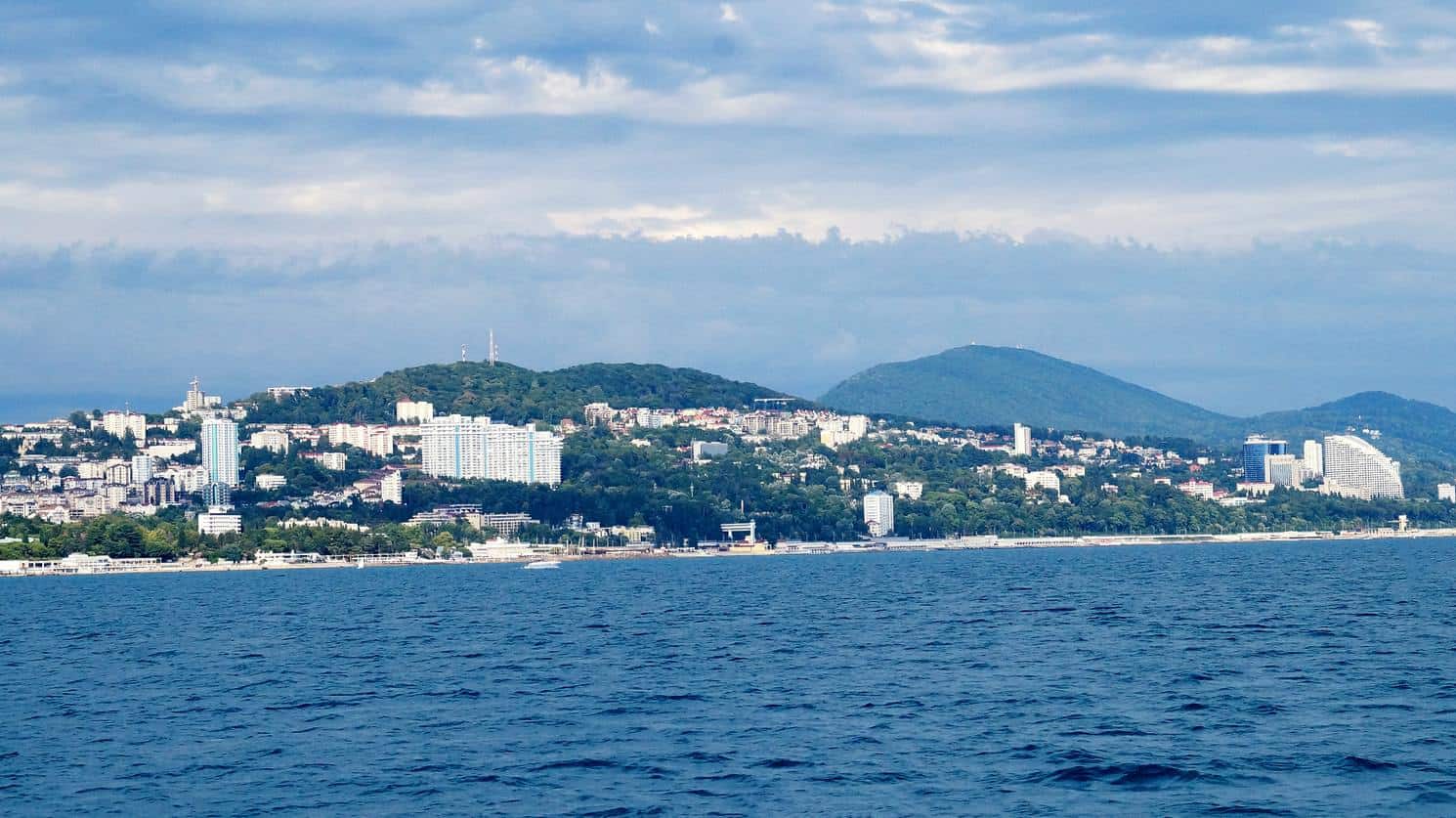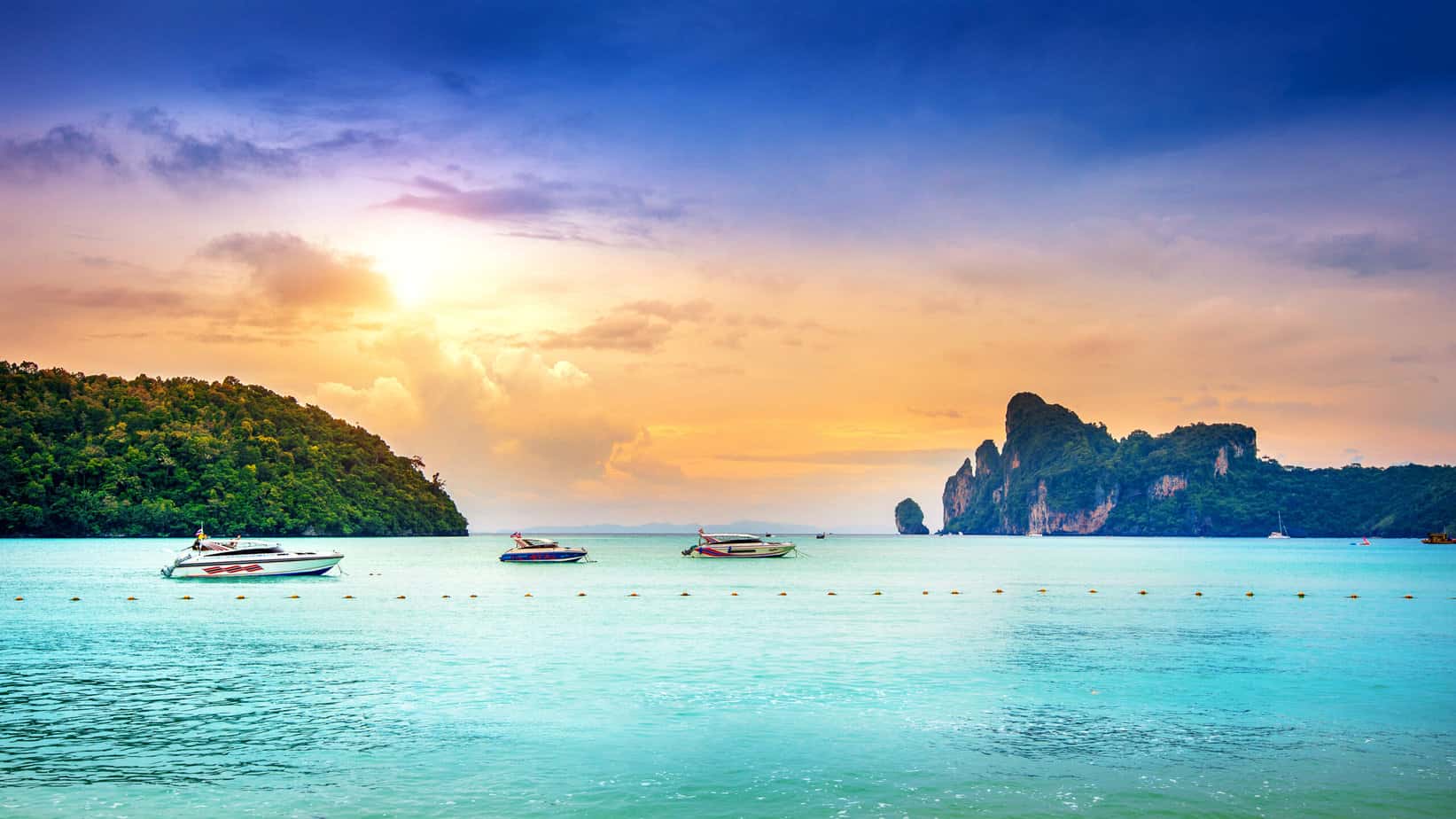Travel Tips
How to Spend a Sunny or Snowy Weekend in Sochi
Published
4 years agoon

Caption: Sochi’s sandy beaches and blue sea are something we might associate with a Caribbean getaway.
Snow and Sochi are not always two things we associate with one another. Sochi has a sub-tropical climate and is one of Russia’s best-known beach resorts. However, just a short trip inland is the famous ski park of Krasnaya Polyana. In one weekend you can sun yourself on the beach and pick up your skis in the mountains. The incredible range of activities on offer makes this a bucket list destination for many. Here’s how to spend 48 hours there.
Stay at Rodina Grand Hotel & Spa
The Rodina Grand Hotel & Spa is undoubtedly the most luxurious hotel in Sochi. All of the rooms look out either onto the beautiful black sea or to the immaculately kept subtropical gardens. While the views out are stunning, the rooms are even more special. Each room is only furnished with natural materials, marble bathrooms, precious wood furniture, and leather upholstery. Royal interior designers were appointed to ensure that the hotel was up to the most exacting standards, and it shows.
Stroll Along Sochi’s Promenade
Sochi’s climate is perfect for beach-goers. The city boasts a long, well-kept promenade, which provides the perfect place to enjoy a morning stroll. Start at the port where you’ll see enormous cruise ships, as well as some privately owned superyachts. If you get lucky then you might even witness a regatta. After you’ve enjoyed the port, make your way along the rest of the promenade, taking in the Olympic Park as you go. Once you’ve found the best bit of beach, stop off and soak up some rays. Perhaps have a swim to build up an appetite, then dry off and take a short walk up to the restaurant for lunch.
Eat at Vysota 5642

Caption: There are lots of traditional dumpling dishes at Vysota 5642 but Khychin might just be the most delicious.
Vysota is a spectacular restaurant near the beach. It’s owned by famous restaurateur Arkady Novikov, who was determined to make this place a foodie destination. If you fancy a taste of home then the burgers here were immediately voted the best in Sochi, bringing together freshly ground, properly seasoned beef and simple toppings. However, if you want to try true Circassian cuisine, then the menu will not disappoint. The Khychin are delicious, combining beet leaves with cheese in a paper-thin casing. So too is the chicken in sour cream. All of the ingredients are sourced locally, from foraged herbs to chickens that have lived an almost wildlife.
Visit Krasnaya Polyana
Krasnaya Polyana is a ski resort just an hour away from Sochi. You can buy a day’s ski pass and enjoy the slopes to your heart’s content. Or if you aren’t particularly sporty, there’s another big draw up here, Casino Sochi. The European Poker Tour is one of the most hotly anticipated events to come to Sochi in recent years and will be returning again in 2021. The Casino Sochi has played host to the tournament and has seen some interesting occurrences in its time. Besides holding regular events it also has a huge selection of table games and slot machines. The building itself is beautiful, with richly decorated interiors, so whether you’re playing the slots, skiing the slopes, or soaking in the scenery, Krasnaya Polyana is definitely worth a visit.
Sample Some Sochi Wine
Russia is most widely known for its vodka, but it has a surprising wine history. Sochi is the region that produces the most wine, some 60% of the country’s output, thanks to its southerly location and warmer climate. Russian wine is fascinating for those with a real interest in wine and delicious even for those who haven’t. Abrau Durso is a short trip away and offers tasting sessions and vineyard tours for real enthusiasts. However, if you’re pressed for time then most of the restaurants around town will be glad to tell you about the local wines on the menu. Of course, if you’d rather there is always a good selection of vodka too, so no need to choose one or the other!
Cole is one half of New Zealand's leading adventure travel blogging couple who have been wearing out their jandals around the world since 2009. He loves any adventure activities and anything to do with the water whether it is Surfing, Diving, Swimming, Snorkeling or just lounging nearby on the beach. You can follow Cole on Google+. Or consider following us via RSS Feed, Twitter, Facebook and subscribe to our Newsletter.

You may like
Travel Tips
How Travel Can Help Clarify Romantic Intentions and Prevent Ambiguous Relationships
Published
1 month agoon
June 12, 2024
Travel Synchronicity and Its Impact on Relationships
The concept of traveling synchronicity plays a crucial role in how romantic getaways are experienced. Studies indicate that when travel plans and expectations are well-aligned between partners, it enhances the overall experience. A harmonious trip results from the absence of misunderstandings, which can be achieved through effective communication of travel plans.
Academic research has highlighted this phenomenon, revealing that a coherent travel plan among partners leads to fewer misunderstandings. Ensuring that both partners agree on destinations, schedules, and activities mitigates the risks of conflicts during the trip. This harmonious planning process significantly contributes to a more enjoyable and less stressful travel experience for both individuals involved.
Clarity in Travel Intentions
Travel intentions play an instrumental role in the quality of a romantic trip. Researchers studying potential and repeat visitors’ travel intentions identified that destination image mediates the relationship between travel motivations and travel intentions. This means that the perception of a destination influences a person’s travel decisions and the purpose behind them.
Teresa Wu’s exploration on the topic, as detailed in her article “What are your travel intentions?”, underscores the relevance of pinpointing the primary objectives or goals of a trip. This methodology aids couples in organizing their activities and optimizing their time and resources. Clear travel intentions ensure that couples can effectively focus on shared goals, whether those are relaxation, exploration, or spending quality time together.
A further examination reveals that online interactions significantly influence travel intentions. A study of Tinder users during the COVID-19 pandemic found that individuals who disclosed more about themselves were more likely to plan future travels. This indicates a link between online self-disclosure and subsequent travel intentions, underscoring the role of transparent communication even before the actual travel process begins. This is particularly relevant in romantic contexts where understanding each other’s preferences and expectations can prevent ambiguity.
Communication, Trust, and Intimacy
Effective communication, trust, and intimacy form the pillars upon which travel intentions can be built and clarified. Online dating provides numerous opportunities to connect with a wide range of individuals, from those looking for serious commitments to those wishing to find an SB online, where shared interests and mutual respect are the foundation of the connection. The level of self-disclosure in these interactions can predict travel intentions significantly, suggesting that openness in online communications may translate to clear travel plans and intentions.
Clear communication about travel plans and intentions ensures that both partners are on the same page, which is essential in preventing misunderstandings. Trust and intimacy, developed through transparent conversations, pave the way for shared travel goals. The findings from various studies demonstrate that couples who communicate openly about their travel desires and intentions are more likely to have fulfilling travel experiences.
In practice, establishing a clear set of objectives for a trip helps manage expectations and aligns partners towards common goals. Whether the purpose is relaxation, adventure, or bonding, clarity in travel intentions reduces ambiguity and enhances the overall experience. By focusing on specific travel goals, couples can create itineraries that cater to their mutual desires and foster stronger relationships.
Conclusion
In summary, travel can serve as a clarifying agent for romantic relationships by promoting alignment in travel plans and intentions. The synchronicity in travel arrangements minimizes misunderstandings and contributes to a harmonious trip. Understanding travel intentions, influenced by factors such as destination image and online interactions, further aids in creating cohesive travel experiences. By emphasizing communication, trust, and intimacy, couples can ensure clarity in their romantic intentions, preventing ambiguous relationships and fostering deeper connections.
Travel Tips
Visiting the UK for the First Time? 10 Things to Consider Doing (2024)
Published
5 months agoon
March 10, 2024
Are you planning a trip to the United Kingdom and feeling a little overwhelmed with all there is to do? No worries! The UK is packed with history, culture, and beautiful landscapes, making it an exciting destination for any traveler. To help you get started, here are ten things you should consider doing on your first visit.
1. Explore London’s Iconic Landmarks
London is often the starting point for many visitors, and for good reason. The city is bursting with iconic sights that you’ve likely seen in movies or read about in books. Be sure to check out:
- The Tower of London: Learn about its rich history and see the Crown Jewels.
- Buckingham Palace: Try to catch the Changing of the Guard ceremony.
- The Houses of Parliament and Big Ben: Snap some photos of these famous structures.
- The London Eye: Get a bird’s eye view of the city from this giant Ferris wheel.
Walking along the River Thames will give you a great perspective of the city’s skyline, too!
2. Take a Day Trip to Stonehenge
Just a couple of hours away from London, Stonehenge is a prehistoric marvel that has stood on the British landscape for thousands of years. It’s a UNESCO World Heritage site and one of the most famous landmarks in the UK. Many tours are available that can provide round-trip transportation and insightful commentary about this mysterious stone circle.
3. Discover the Scottish Highlands
If time allows, venture north to Scotland and experience the breathtaking beauty of the Scottish Highlands. With its rugged mountains, serene lochs (lakes), and sweeping glens (valleys), it’s an area of outstanding natural beauty. You might even want to try spotting the elusive Loch Ness Monster while you’re there!
4. Play the Irish Lottery
While exploring the UK, many travelers try their luck with the Irish Lottery. While based in Ireland, the Irish Lotto remains popular in the UK among locals and visitors alike. People can purchase a ticket from authorized retailers like Lottoland.
5. Visit Historical University Towns
The UK is home to some of the world’s most prestigious universities, and the towns of Oxford and Cambridge are well worth a visit. Wander around the historic college buildings, admire the architecture, and maybe even take a punt (boat) down the river. Both towns have a unique charm and are brimming with history and culture.
6. Enjoy Traditional British Cuisine
Your trip won’t be complete without trying some traditional British food. Fish and chips are a must-have, ideally enjoyed by the seaside. Also, don’t miss out on a classic Sunday roast at a local pub, complete with Yorkshire pudding and gravy. For something sweet, afternoon tea is a charming British tradition where you can indulge in scones, sandwiches, and a selection of teas.
7. Wander Through the Lake District
The Lake District is England’s largest National Park and a UNESCO World Heritage site, renowned for its stunning lakes, forests, and mountains. It’s the perfect place for outdoor enthusiasts. Whether you prefer hiking, cycling, or simply picnicking by the water’s edge, the natural beauty here is sure to leave you in awe. Don’t forget to visit the charming villages like Windermere and Keswick.
8. Experience the Welsh Culture in Cardiff
Cardiff, the capital of Wales, offers a blend of ancient history and modern Welsh culture. Explore Cardiff Castle, stroll through Bute Park, or catch a rugby match to experience the national sport and passion of Wales. The city also boasts a vibrant waterfront at Cardiff Bay, where you can find delicious Welsh cuisine and entertainment.
9. Attend a West End Show in London
For theatre lovers, attending a show in London’s West End is a must-do. The area is famous for its high-quality theatrical productions, ranging from musicals and comedies to classic dramas and new works. There’s something magical about spending an evening in one of the historic theatres, enjoying world-class performances that you’ll remember long after the curtain falls.
10. Visit the Giant’s Causeway in Northern Ireland
A trip to the UK wouldn’t be complete without seeing the Giant’s Causeway in Northern Ireland. This natural wonder consists of 40,000 interlocking basalt columns, give or take, resulting from an ancient volcanic eruption. Legend says it was built by giants, and as you walk the coastal path with the Atlantic Ocean crashing beside you, it’s easy to see why this myth persists. It’s a truly unique and unforgettable sight.
Remember, the UK is more than just its sights; it’s the experiences and the people that make a trip truly memorable. So, chat with locals, take in the scenery, and immerse yourself in the culture. Have a fantastic trip!
Content to be used for social media sharing
Did you get receive an inheritance or own the Lottoland’s lottery and are planning a trip to the UK? Here are 10 things to consider doing next time you visit the United Kingdom.
Travel Tips
Exploring Equatorial Guinea: A Journey through the Heart of Africa
Published
5 months agoon
March 6, 2024
Tucked away in the western part of Central Africa lies Equatorial Guinea, a nation often referred to as the “Heart of Africa” due to its geographical location straddling the equator. This small yet captivating country comprises the mainland region called Rio Muni and several islands, with Bioko being the largest and most populous. Exploring Equatorial Guinea is akin to embarking on a journey through a microcosm of Africa’s diverse landscapes, cultures, and history. So, if you are in the mood to plan a trip to this wonderful land, make sure to check out eVisa in order to keep things going easily and plan stress-free.
A Tapestry of Landscapes
Equatorial Guinea’s geography is as varied as it is stunning. From dense rainforests to pristine beaches and volcanic landscapes, this country offers a tapestry of natural wonders waiting to be discovered. The lush rainforests of Bioko Island are a haven for biodiversity, home to rare species such as the drill monkey and the African grey parrot. Hiking through the dense foliage, one can encounter cascading waterfalls, hidden lagoons, and endemic flora that thrive in this ecological paradise.
Venturing to the mainland, Rio Muni unveils a different facet of Equatorial Guinea’s landscape. Here, expansive savannas stretch as far as the eye can see, interrupted by winding rivers and rolling hills. The Monte Alen National Park, a UNESCO Biosphere Reserve, offers intrepid travelers the chance to witness elephants, gorillas, and other wildlife roaming freely in their natural habitat. Explorations along the Rio Muni River reveal traditional villages where ancient customs and traditions are still preserved, providing a glimpse into the rich cultural tapestry of Equatorial Guinea.
Cultural Encounters
Equatorial Guinea is a melting pot of cultures, with influences from indigenous tribes, Spanish colonial heritage, and neighboring African nations. This diversity is reflected in the country’s vibrant music, dance, and cuisine. Traditional rhythms reverberate through the streets during festivals and celebrations, where locals clad in colorful attire showcase their ancestral dances passed down through generations.
The capital city, Malabo, offers a fascinating blend of old-world charm and modernity. Spanish colonial architecture stands side by side with contemporary structures, creating a unique juxtaposition of styles. The bustling markets of Malabo are a feast for the senses, with vendors selling fresh produce, spices, and handicrafts crafted by local artisans. Exploring the city’s museums and galleries provides insight into Equatorial Guinea’s history, from its pre-colonial roots to its struggle for independence and subsequent development.
Island Escapes
Equatorial Guinea’s islands offer a perfect escape for those seeking sun, sand, and sea. Bioko Island boasts pristine beaches fringed by coconut palms, where azure waters beckon travelers to swim, snorkel, and dive amidst colorful coral reefs teeming with marine life. The island’s volcanic peaks provide a dramatic backdrop for exploration, with opportunities for hiking, birdwatching, and even volcano trekking for the adventurous.
Off the coast of Rio Muni lies the tranquil island of Annobón, a secluded paradise untouched by mass tourism. Here, time seems to stand still as visitors immerse themselves in the laid-back island lifestyle, characterized by warm hospitality and breathtaking natural beauty. Snorkeling in crystal-clear waters, exploring hidden coves, or simply unwinding on deserted beaches are among the activities that make Annobón a hidden gem waiting to be discovered.
Conclusion
Exploring Equatorial Guinea is a journey of discovery, where every corner reveals a new facet of Africa’s rich heritage and natural splendor. From the lush rainforests of Bioko to the pristine beaches of Annobón, this small yet diverse country offers endless opportunities for adventure, cultural immersion, and relaxation. Whether you’re a nature enthusiast, a history buff, or simply seeking an off-the-beaten-path destination, Equatorial Guinea promises an unforgettable experience that will leave a lasting impression on all who visit.
Meet Cole and Adela
 We have been wearing out our jandals (Kiwi for flip-flops) on our travel adventures around the world since 2009. We think our blog is thought provoking and a little witty. But we have been proven wrong before. Find out more about us here...
We have been wearing out our jandals (Kiwi for flip-flops) on our travel adventures around the world since 2009. We think our blog is thought provoking and a little witty. But we have been proven wrong before. Find out more about us here...
Find
New on Four Jandals
What Are You Looking For?
- Adventure Travel (235)
- Africa (25)
- Asia (31)
- Auto (2)
- Business (5)
- City Guides (26)
- Entertainment (7)
- Europe (177)
- Food (16)
- Home (4)
- Inspiration (12)
- North America (51)
- Oceania (32)
- Other (219)
- Personal Musings (9)
- Reviews (16)
- Technology (11)
- Travel Blogging Tips (9)
- Travel Tips (282)

